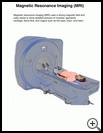
Magnetic Resonance Imaging (MRI)
________________________________________________________________________
KEY POINTS
- Magnetic resonance imaging (MRI) uses a strong magnetic field and radio waves to show detailed pictures of the organs and structures in your child’s body.
- MRIs are used to diagnose injuries and diseases.
- With most machines, your child will lie on a narrow bed that moves through the MRI machine. Most MRIs take 30 to 60 minutes and some take longer. Tell your child’s provider if your child has anxiety or fears when in small or crowded spaces.
________________________________________________________________________
What is magnetic resonance imaging (MRI)?
Magnetic resonance imaging (MRI) uses a strong magnetic field and radio waves to show detailed pictures of the organs and structures in your child’s body. While an X-ray is good at showing bones, an MRI can show more than an X-ray including muscles, ligaments, cartilage, blood flow, and organs such as the eyes, brain, and heart.
When is it used?
Healthcare providers use MRI scans to see detailed images of almost any place in the body. For example, they may use them to:
- Diagnose injuries and diseases of bones and the soft tissues that connect them to muscles or other bones
- Diagnose conditions that affect the brain or spinal cord
- Look for causes of developmental delay
- Diagnose cancer
If your child has any metal in his or her body, such as plates or screws from a previous surgery or a cochlear implant, tell your child’s healthcare provider. Some types of implants should not be scanned.
How do I prepare my child for this procedure?
Usually no preparation is needed for an MRI, but in some cases your child’s healthcare provider may give you instructions to follow before the scan. Your child’s instructions may include:
- Changes to how your child takes medicines
- What your child can eat and drink before the MRI
- Getting other tests or procedures
Metal will interfere with the scan, so follow these steps:
- Your child should wear comfortable clothing that has no metal zippers, hooks, or clasps. Leave watches and jewelry at home.
- If your child has an external medical device, he or she may need to remove it before the MRI scan.
- Some medicine patches put on the skin contain metals. The patches could overheat during an MRI and burn your child’s skin. If your child wears a medicine patch, it may need to be removed before an MRI. Talk with your child’s healthcare provider about this.
- Tell your child’s healthcare provider if your older child is or may be pregnant or is breastfeeding.
Most MRI machines are tunnel shaped, which means your child will be in a small space during the scan. Tell the healthcare provider if your child has anxiety or fears when in small or crowded spaces. The provider may give your child medicine to help him or her feel less nervous, or your child may be able to go to a site with an open MRI scanner.
What happens during the procedure?
With most machines, your child will lie on a narrow bed that moves through the MRI machine. Some machines move over the bed. Your child will need to be still during the scan so the pictures will not be blurry. Your child may be given medicines that make him or her feel relaxed, but he or she may stay awake during the test if he or she is older. Sometimes your child will be given IV fluid called contrast dye before the MRI to make the areas in your child’s body easier to see.
Most MRIs take 30 to 60 minutes and some take longer. Your child will hear knocking and a whirring sound while the pictures are being taken. If you are concerned that the noise will bother your child, ask the person doing the scan if your child can wear earplugs or listen to music during the scan. Your child will be able to speak with the person doing the scan so he or she can let them know about any problems.
What happens after the procedure?
When the scan is over your child may go home. Ask your child’s healthcare provider how and when you will get your child’s test results.
What are the risks of this procedure?
Every procedure or treatment has risks. Some possible risks of this procedure include:
- Rarely, your child may have an allergic reaction to contrast dye used during the procedure.
Ask your child’s healthcare provider how the risks apply to your child. Be sure to discuss any other questions or concerns that you may have.
Last modified: 2021-12-07
Last reviewed: 2019-04-28

